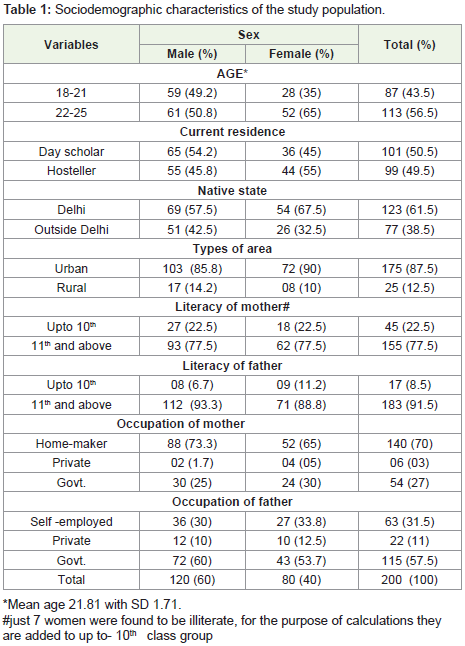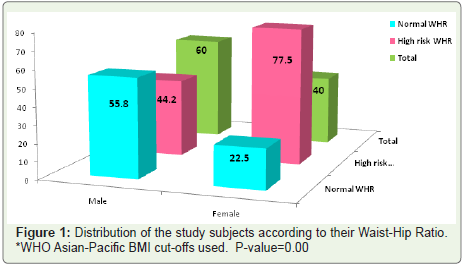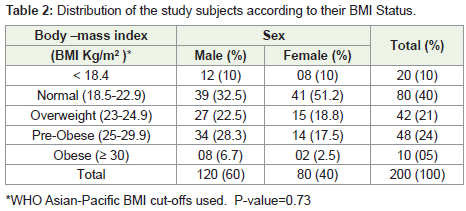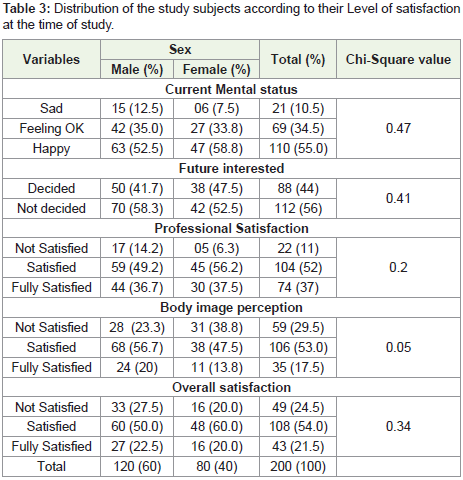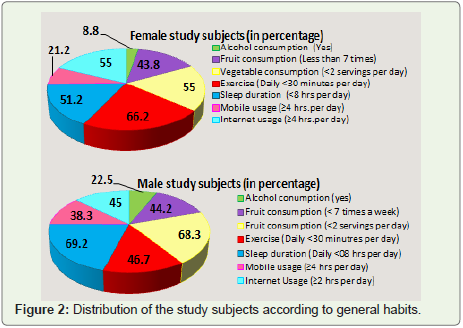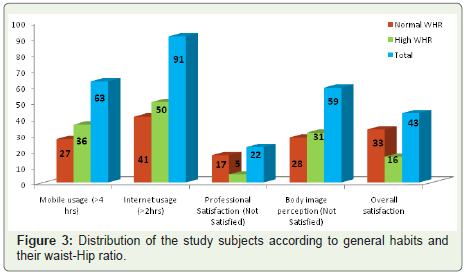Research Article
Determinants of Obesity among Medical College Students of Delhi-a Cross Sectional Study
Sulania A*, Setu Y and Goel SK
Department of Community Medicine, India
*Corresponding author: Sulania A, Md Community Medicine (Lhmc), Department Of Community Medicine, Sector-6, Rohini, Delhi, India, Phone number: 9873743493; E-mail- dr.anikabsa2020@gmail.com
Article Information: Submission: 22/12/2020; Accepted: 15/01/2021; Published: 18/01/2021
Copyright: © 2021 Sulania A, et al. This is an open access article distributed under the Creative Commons Attribution License, which permits unrestricted use, distribution, and reproduction in any medium, provided the original work is properly cited.
Abstract
Introduction: Non-Communicable Diseases (NCDs) or life style diseases, including heart diseases, strokes, cancer and chronic lung disease, are collectively responsible for almost 70% of all deaths worldwide. Four Modifiable behaviour risk factors are responsible for significant proportions of these diseases-Tobacco use, unhealthy diet, physical inactivity and harmful use of alcohol. Prevalence of risk factors for NCDs is found to be high in medical college students. It is necessary that the students have correct knowledge about life style diseases and their prevention which they can translate to their patients also. Keeping this in the mind the study has been designed to assess the factors for obesity and knowledge in preventing those risk factors among medical students.
Methodology: A cross-sectional descriptive study was conducted amongst MBBS students. Complete enumeration of the student’s population was done for the purpose of study with informed written consent. A pretested questionnaire was used to collect sociodemographic and their life style related information and the standard Definition of WHO was used for anthropometric measurement.
Results: Out of 200 students, 56.5% of the study subjects belonged to 22-25 years of age group. Twenty four percent of the students belonged to Pre-Obese category (BMI=25-29.9) with 70.8% of males and 29.2% of females, 21% of students belonged to Overweight category (BMI=23-24.9) with 64.2% of males and 35.7% of females, 10% of students belongs to underweight category (BMI=< 18.4) with 60% of males and 40% of females. Only 5% of students belonged to Obese category (BMI=≥30) with 80% of males.
Conclusion: Prevalence of overweight and obesity is increasing in Medical college students and in our study, Prevalence of both was found to be 50% combined. The main factors responsible were imbalance diet with lack intake of fruits and vegetables, inadequate sleep and physical activities and excess time spending on gadgets and internet surfing. This highlights the need of healthy lifestyle, Healthy food habits and adequate physical activity as a part of their daily routine.
Keywords
Determinants; Obesity; Non communicable disease; Medical college students
Introduction
Non-Communicable Diseases (NCDs) or life style diseases, including heart diseases, strokes, cancer and chronic lung disease, are collectively responsible for almost 70% of all deaths worldwide [1,2]. Almost three quarters of all NCDs related deaths, and 82% of the 16 million people who died prematurely, or before reaching 70 years of age, occur in low-and -middle income countries [3]. Four NCDs namely cardiovascular diseases, cancer, chronic respiratory diseases and Diabetes make the largest contribution to morbidity and mortality due to NCDs. Four Modifiable behaviour risk factors are responsible for significant proportions of these diseases-Tobacco use,
unhealthy diet, physical inactivity and harmful use of alcohol [4,5]. Of all the risk factors, physical inactivity and associated overweight and obesity accounts for maximum morbidity. Most of the world’s population lives in a country where overweight and obesity kills more people that underweight [6]. Social implications of obesity are
a major problem area that is often neglected. The obese, do less well academically, have poorer job prospects and lower self-esteem [7].
The total costs associated with overall management of NCDs make the prevention and control of these diseases a major development imperative for 21st century. More over most of the premature deaths from NCDs are largely preventable. Risk factors which are common to all lifestyle related diseases are Alcohol drinking, Low physical activity, Tobacco consumption and unhealthy diets. All of these risk factors can be assess in early adulthood days and corrective actions should be started at primordial or primary level of prevention to
prevent the NCDs from happening or halting their progress. Also according to the recent studies prevalence of risk factors for NCDs including Obesity and overweight are high amongst medical college students [8]. And the trend is towards increase only .Medical students are important targets for promoting healthy lifestyle. As a future doctor, it is necessary that the students have correct knowledge about the diseases and prevention which they can translate to their patients also. It is relevant to assess the obese and overweight students to timely initiate the preventive process. Keeping all these in mind the current study was planned with the aim to “Assess risk factors profile for non-communicable diseases in medical college students of Delhi”.
Methodology
Setting and study participants:
It was a cross-sectional descriptive study. Two MBBS batches of were considered for study. One batch consists of 100 students. Complete universe of students was taken with informed written consent. They were explained about the purpose of the study and given the option to withdraw at any stage of the interview. However none decline to participate. Interview was carried out in a confidential, non-obligatory and non-judgmental manner. Anonymity of the study participants was ensured and utmost confidentiality of the information collected was maintained.Study instruments:
A Predesigned and pretested semi-structured interview schedule
was used for this study. The face validity and the content validity
were assessed by peer review of the questionnaire with the experts
in field. Questionnaire consists of few basic socio-demographic
detail including age, gender, residence and few questions regarding
general habits such as frequency of fruit and vegetable consumption,
alcohol intake, smoking, exercise and sleep habits etc. to assess
overall attitude of the student towards his or her own wellbeing.
Followed by complete anthropometric measurement of the students,
parameters were: weight was recorded by digital weighing scale
corrected to nearest zero. The participants were made to stand after
removing heavy jackets and footwear with standing straight. Height
was measured by Stadiometer with adjustable sliding horizontal
head piece [9]. Waist and Hip circumference were measured by nonstretchable
inch tape. For waist circumstance the mid- point between
costal margins and the iliac crests was taken. For Hip-circumference
the area with maximum bulge or contour was taken as a reference
point. Parameters were recorded by trained health staff under the
supervision of investigators. Current level of satisfaction was also
measured by current mental status, professional satisfaction, body
image perception and overall satisfaction. All three parameters were
measured by 3 point Likert scale.Those who were found to have high BMI or high Waist-hip ratio
were counseled about the risk of NCDs and prevention including
modification in diet and adaptation of general healthy practices.
Referrals were made for clinical evaluation wherever required.
Operational definitions:
For BMI: BMI was calculated as weight in Kilograms divided by the square of the height in Meter (Kg/m2). Asian-Pacific classifications was used with the following cut-offs-Underweight (<18.5 Kg/m2), Normal weight (18.5-22.9 Kg/m2), Overweight (23-24.9 Kg/m2), &Obese (≥25 Kg/m2) [10]Waist-hip ratio (WHR) was calculated by dividing the waist circumference and hip circumference in centimeters. The level of risk according to WHR for males was taken as >1.0 and in females was taken as >0.85. For Sleep, more than 08 hours of sleep per day was considered as good practice. For Exercise/Physical activity, minimum
of 30 minutes or more duration of moderate intensity per day was considered healthy [11]. Similarly for mobile use, usage of ≤ 04 hrs per day and for internet use, usage of ≤02 hrs per day was considered as healthy practice. For fruit consumption, the number of fruit intake per week was asked and Minimum 07 times per week considered normal. For vegetable consumption, the number Katori of vegetable consumed per day was asked and Minimum 02 times per day was considered healthy.
Data management and statistical analysis:
Information was collected about demographic characteristics, Education, type of residence, whether the students is day scholar or hosteller and type of occupation. The data was coded and analysis carried out using SPSS version 16. Qualitative data was expressed as proportions and Chi Square test was used to find association between the variables. Quantitative data was analyzed in term of mean and standard deviation and considered significant at p<0.05.Results
The study was designed to assess the risk factor profile regarding NCDs in undergraduate MBBS students. Total 200 students were studied. Out of 200 students, 56.5% of the study subjects belonged to 22-25 years of age group with 65% of female students and 43.5% belonged to 18-21 years of age group with 49.2% of male students. The mean age calculated was 21.8 years with SD 1.71. Distribution according to place of residence was almost equal in day scholars and hosteller category. 54.2% of male subjects and 45% of female subjects were day scholar and were (61.5%) residing in Delhi city. However area wise almost 90% of study subjects were found to be staying in urban areas.
On considering educational status of parents, 91.5% of fathers and
77.5% of mothers of study subjects were literate till 11th and above. It
was also observed that 57.5% of father’s were working as government
employee, 31.5% were self-employed and 70% of mothers were
home-maker, 27% were working as government employee as shown
in Table 1.
Figure 1 depicts distribution of study subjects according to
Waist-Hip ratio, usually taken to check the central obesity and the
likelihood of developing Non Cardiovascular diseases in future. Out
of 120 male study subjects, 55.8% were found to be falling in high
risk category and out of 80 female study subjects, 77.5% were under
high risk category. The association with gender and waist hip ratio
was found to be statistically significant with p-value=0.00. Table 2
Depicts distributions of study subjects according to Body Mass Index
(BMI) and it was observed that 40% of the students belong to normal
category (BMI=18.5-22.9), with 51.2% of females and 32.5% of males
and 21% of students belongs to Overweight category (BMI=23-24.9) with 22.5% of males and 18.8% of females, Twenty four percent of the
students belongs to Pre-Obese category (BMI=25-29.9) with 70.8%
of males and 29.2% of females within pre-Obese category (row total
percentage, not shown in table). Only 5% of students belongs to Obese
category (BMI=≥30) with 80% of males and 20% of females within
the Obese category (row total percentage, not shown in table). 10%
of students belong to underweight category (BMI=< 18.4). In total
Overweight, pre obese and obese category covered 50% of the study
individuals. Distribution of the BMI along with Waist -Hip ratio has
also been observed. It was found that those falling in Overweight and
obese category have higher Waist to hip ratio. The association has
been found to be significant with p-value=0.029 (not shown in table).
Figure 1: Distribution of the study subjects according to their Waist-Hip Ratio.
*WHO Asian-Pacific BMI cut-offs used. P-value=0.00
Table 3 Depicts distribution of study subjects according to their
level of satisfaction at the time of study. In observing the current mental
status at the time of study, it was observed that 55% of study subjects
were happy (57.3% males and 42.7% females), 34.5% of study subjects
were feeling OK (60.8% males and 39.1% females), and 10.5% of study
subjects were found to be sad (71.4% males and 28.5% females). If
future interest of the study subjects was considered, it was observed
that only 44% of the study subjects have already decided about their
future medical branches in career. About Professional Satisfaction of
the study subjects and it was observed that 52% of the students were
satisfied with 56.7% males, 43.2% females. Almost 1/4th of students
were not satisfied with their professional choices with 67.3% of males
and 32.6% of females. In case of body image perception of the study
subjects and it was observed that 53% of the students were satisfied
with 64.1% males, 35.8% females. Almost one third of the students
were not satisfied with their body image with 47.4% of males, 52.5%
of females. The results were found to be statistically significant with
p-value is 0.05. Regarding overall satisfaction of the study subjects
and it was observed that 54% of the students were satisfied with 55.5%
males, 44.4% females.
If we consider few of the practices adopted by the students for their general well -being, [Figure 2 it has been found that almost one sixth
of the study subjects were consuming alcohol with 79.4% of males
and 20.6% of the females and the results were found to be statistically
significant with p-value 0.01 Regarding per week fruits consumption,
it was found to be slightly more in female students (56.2%) as
compared to males (44.2%), though no statistically significant
association has been found between two genders. For vegetable
consumption assessment, again females were found to be consuming
more vegetables as compared to males and the result was found to
be statistically significant with p-value 0.05.On considering exercise
for minimum 30 min. in a day, males were found to be exercising
more (53.3%) as compared to females (just 33.8%) and the results
were found to be statistically significant with p-value 0.00.For sleep
duration (More than 8 hours per day) females study subjects were
found to be sleeping more soundly(48.8%) than males study subjects
(30.8%) with the statistical significant result with p-value 0.01.Almost
75% of the males’ study subjects were found to be using mobile and
excessive Internet. Regarding the use of mobiles and internet in their
daily life .Males study subjects were found to be using mobile more
than 4 hours (38.8%) and more number of females (55%) were found
to be using more than 2 hours of internet. Results were statistically
significant for both the variables as shown in Figure 3. On examining
the distribution of study subjects according to general habits and their
waist-Hip ratio (not shown in table) it was noted that those who are
falling in high risk category according of waist -hip ratio have more mobile usage hours (57.1%), more internet usage (55%), not satisfied
with body image (52.5%).With professional satisfaction approx.. onetenth
of study subjects are not satisfied and for overall satisfaction
almost 0ne-fourth of the study subjects are not satisfied. Also it was
found that among those study participants with obese BMI category,
only 44% (38/141) were satisfied and 64.4% (38/59) were not satisfied
regarding their body image perception. Overall statistical significant
association was found between body image perception and the waist
-hip ration with p-value 0.05 as shown in Figure 3.
Table 3: Distribution of the study subjects according to their Level of satisfaction
at the time of study.
Discussion
Both primordial prevention and primary prevention plays important in NCDs emergence. Being in Medical profession, medicos are considered to have higher knowledge regarding the matter and practicing what they are preaching however in most of the research studies as discussed below it has been found that almost all the risk
factors persists in medical students also as compared to general masses. In our cross-sectional observational study, BMI assessment of MBBS students was done and along with that few general practices associated with being healthy were also assessed.
In our study the prevalence of Overweight and Obesity was found to be 21% and 29% respectively. The findings are similar to many other studies done to find out the prevalence of obesity in medical colleges students .In an Egyptian study done on medical college students the combined prevalence of overweight and obesity was
found to be 49%. Bakr et al. in Egypt demonstrated as 49% (37% & 12% respectively). Similarly in a study done in Bangalore by Gore et.al the combined prevalence was found to be 41.2% [12-14]. Many other studies around the world reported the similar pattern [15-20]. However it is a notable fact that the obesity and overweight pattern has been increased over that last decades. In many a decadal old studies the prevalence reported were less as compared to current studies [21-24]. Both obesity and overweight were found to be more in males as compared to females [21-2325]. This should be taken care of in students life only as we know the growth of body in adult life generally follows the pattern of weight gain in adolescents time period only so if a student’s is overweight or obese he or she will likely to retain the pattern unless there is an intervention in the form of diet control and physical activity. According to one study small changes in weight and increase in physical activity can make a significant improvement in health [26].
Regarding Waist to hip ratio, more female’s participants were
found to have higher (77.5%) waist -hip ratio falling in high risk
category as compared to males (22.5%). Similar results were found
in studies done by Gudegowda KS in Bangalore, Varadappa et al.
in Bangalore and Selvaraj et al. [27-29]. It may be due to gender
related genetic predisposition of fat cell accumulation. It increase in
WHR is a significant risk factor for non-communicable especially
cardiovascular diseases.
In our study we found that 50% of the study subjects were not consuming adequate fruits and roughly two-third of the participants were consuming vegetables less than recommended. Results were found to be similar to study done by Guleri SK et al. where she found that study participants diet were deficit both in fruits and vegetables by 50% and 90% respectively [30-32]. Fruits and vegetables are necessary
for proper functioning of body and mind. Decrease in their amount put participants in direct risk of CVDs and Many other diseases.
Almost 30% of the study individuals, who found to be having high WHR were not satisfied with their body image, the number of girls were slightly more (53%) than of males. In general it has been found that girls are more conscious about the body image as boys as shown in our study with significant association. Somewhat similar
results were mentioned in by Deotale MK et.al. [33].
In general, physical activity levels were found to be low in MBBS students throughout world [12,34]. Medical students found to be least engaged in such activities probably due to their busy schedule and long hours of sitting. In present study 45.56% of the students
were found to engage in any kind of physical activity for minimum of 30 minute duration in a day. The level was found to be more in males (70%) as compared to females (30%).Ina study done in Greece, only 60% students were found to be engaged in physical activities [35]. If we discuss about gadget use, more than 31% of the study individuals found to be using Mobile and internet usage for more than 2 hours daily was found in 45% of the individuals with significant association. Similar results were found in other studies also. In a study done in Bangalore medical college by Gudegowda KS et al. found out that those who are using gadgets for more than 20 hours a week are at the risk of being overweight and obesity.
Conclusion & Recommendations
Most of the risk factors and premature deaths due to NCDs are preventable by alternation in lifestyle. Prevalence of overweight and obesity is increasing in MBBS students and in our study it was found as 50% combined. This highlights the need of healthy lifestyle, Healthy food habits and adequate physical activity as part of their daily routine. It should be included as part of their curriculum and should be strictly followed. Also the importance of balanced diet should be taught extensively in medical curriculum. Adequate facility for gym and sports and for conducting Yoga classes should be provided to students with some separate area and time period allotted for recreational activities only.
Limitation
Sample size is less to extrapolate findings to other medical colleges. Blood samples cannot be collected for Detecting of Non communicable diseases or risk factors.
Acknowledgement
The authors are heartily thankful to the undergraduate medical students who participated in this study.

